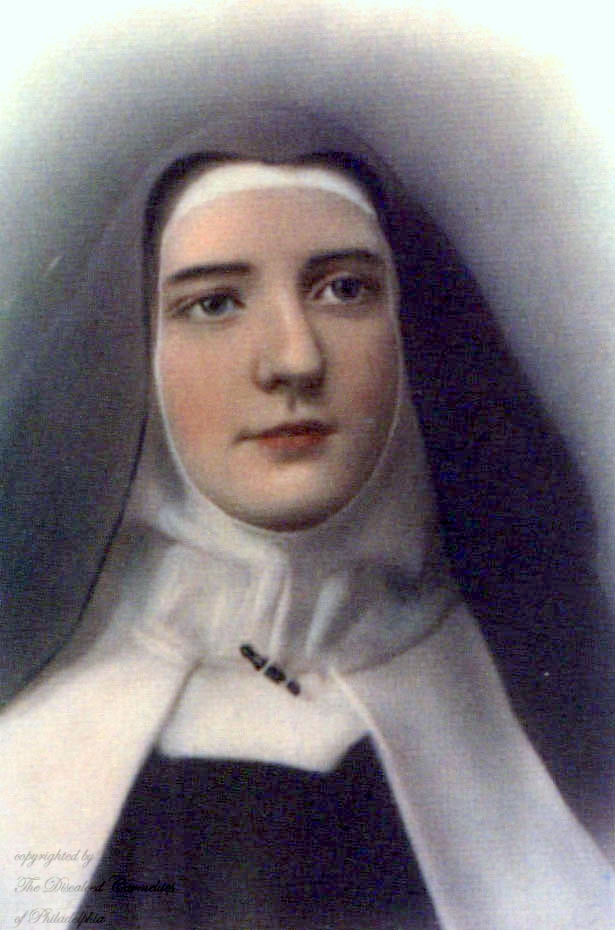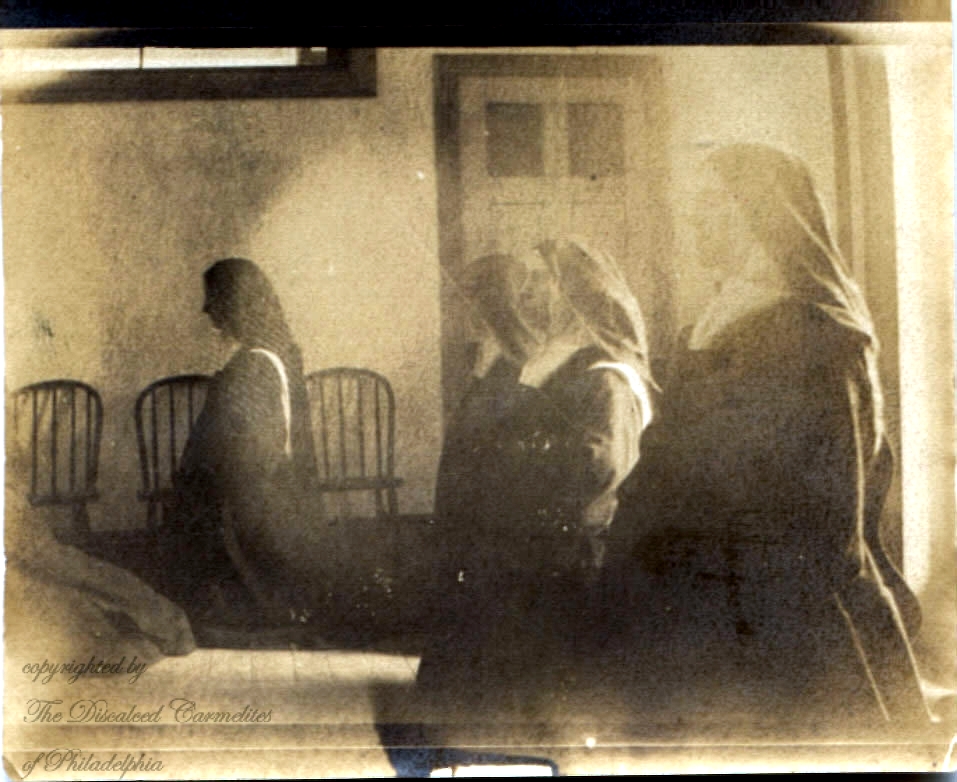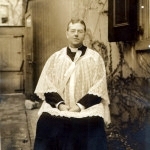Letters from St. Therese's Sister Pauline, Mother Agnes of Jesus, to Sister Stanislaus of the Blessed Sacrament, "Philadelphia's LIttle Flower" - Part 2 - September 1, 2014
 Sister Stanislaus of the Blessed Sacrament, O.C.D.
Sister Stanislaus of the Blessed Sacrament, O.C.D.
Read part one of "Sister Stanislaus of the Blessed Sacrament."
On July 25, 1902, Sister Stanislaus of the Blessed Sacrament rode a train from Boston to her native city, Philadelphia. She was accompanied by two other young women from Philadelphia who, like her, had been parishioners at the Church of the Gesu and were educated by the Sisters of Notre Dame de Namur: Sister Mary of St. Joseph and Sister Xavier of the Angels. With them was their new prioress, Mother Gertrude of the Heart of Jesus, who came from a family in New York City, but she had been educated at the Academy of the Holy Child at Sharon Hill in the Philadelphia suburbs. These four young women came to be known as "the four foundresses." Mother Beatrix of the Holy Spirit, prioress of the Boston Carmel,accompanied them to the temporary monastery at 1518 Poplar Street, the fifth Carmel founded in the United States.
 The four foundresses in the chapel of the Poplar Street houseThe next day Archbishop John Patrick Ryan offered the first Mass at the new foundation. For three days, before the enclosure was sealed, the young nuns held "open house" at Poplar Street. Many guests visited, among them the future St. Katharine Drexel and her sister, Louise Morrell; the latter made a generous donation on the spot and contributed generously to the monastery every month for the rest of her long life.
The four foundresses in the chapel of the Poplar Street houseThe next day Archbishop John Patrick Ryan offered the first Mass at the new foundation. For three days, before the enclosure was sealed, the young nuns held "open house" at Poplar Street. Many guests visited, among them the future St. Katharine Drexel and her sister, Louise Morrell; the latter made a generous donation on the spot and contributed generously to the monastery every month for the rest of her long life.  Father John J. Moore, first chaplain of the Philadelphia Carmel
Father John J. Moore, first chaplain of the Philadelphia Carmel
Father John J. Moore was assigned to be the nuns' chaplain. Together with Sister Mary, Sister Stanislaus was assigned as portress, the nun who answered the "turn" and communicated with the faithful seeking prayers, with other guests, and with workmen. The two portresses seized every opportunity to tell the people about St. Therese, then called "The Little Flower." Sister Stanislaus was also infirmarian (nurse) for the little community and was the first "councilor" (nun who advised the prioress). From 1902 she was already in correspondence with St. Therese's sister Pauline (Mother Agnes of Jesus, prioress of the Lisieux Carmel). We may imagine her working hard to spread devotion to St. Therese during the years in which she wrote to Mother Agnes and received the letters described below.
The first letter to Sister Stanislaus from Mother Agnes that survives at Philadelphia is dated May 1, 1903. Mother Agnes refers to the increasing persecution of the Church by the French government and writes that the Lisieux Carmelites expect to be evicted from their monastery, as many other religious communities had been. Mother Agnes mentions that she has been prioress for a year, ever since Mother Gonzague completed two six year-terms "and it was impossible, unfortunately, to re-elect her." She thanks Sister Stanislaus for her account of the good done by rose petals touched to Sister Therese's grave which she had sent to Philadelphia, and says "This is happening everywhere." At this time no proceedings had been opened for Sister Therese; indeed, it was in this year of 1903 that the Scots Father Thomas Taylor, visiting the Lisieux Carmel, was the first to suggest the idea that Sister Therese should be beatified.
The second letter, July 17, 1903, shows that Sister Stanislaus had asked permission to translate and publish a book about St. Therese. Mother Agnes regrets that she can't take the right from her London publishers. She describes the persecution again and rejoices at the graces (of which Sister Stanislaus has told her) being received by the friends of Sister Therese in the United States. Mother Agnes's language suggests that Sister Stanislaus had asked to see the unpublished writings of Sister Therese:
. . . desire no longer to understand pages that you will only be able to read in heaven. Ah, my dear little child, let us write like this: let us leave all the pages of our own lives to be read only in heaven. Do not regret anything. Thérèse will have you taste all of her secrets later on. You will be together forever in the garden of heaven.
In Mother Agnes's third letter, October 9, 1903, she said she has sent to Philadelphia some rose petals touched to the grave of Sister Therese. She expresses her anguish at the illness of Sister Marie of the Eucharist, her cousin Marie Guerin, who is suffering from tuberculosis (though Mother Agnes does not disclose the disease here), and says that the illness had been kept private till now. (Sister Marie of the Eucharist would die in April 1905). She tells Sister Stanislaus where to write for a catalog of French books about St. Therese. Mother Agnes remarks that Sister Genevieve (Celine) has completed the drawing of Therese at the feet of the Holy Father, which will appear in the next edition of Story of a Soul.
On December 8, 1903, Mother Agnes wrote again, promising the prayers of her Carmelites for Mother Gertrude, who is in poor health and for whom Sister Stanislaus is caring. She writes about a pamphlet being printed in English about Sister Therese, which is to be sent to Philadelphia and says that her cousin, Sister Marie of the Eucharist, is better.
On November 23, 1904, the Philadelphia Carmel moves to a larger temporary home on the southwest corner of 44st and Spruce Streets. During the Christmas holidays, on December 29, 1904, Mother Agnes writes again, sending the account of the life of Mother Marie de Gonzague, Therese's prioress, who had just died on December 17, 1904. Mother Agnes adds "let us not be saddened too much over the death of saints." She reports that Sister Marie of the Eucharist (Marie Guerin) is stil very ill.
No letters survive from 1905. On January 6, 1906, Mother Agnes writes to Mother Gertrude in answer to a letter from Mother Gertrude. She refers again to the rising persecutions. The French government was inventorying the property of religious communities with the intention of seizing it. Mother Agnes thanks Mother Gertrude for telling her about the graces St. Therese has obtained for her and for other members of the Philadelphia Carmel:
“Oh, how this angel loves and blesses your monastery! Rather, it is quite right that she reserve for it her most beautiful roses: love and confidence in God . . . .
Our community is very honored to feel itself so united to your dear ones, my Reverend Mother.”
sister Stanislaus receives a letter Mother Agnes wrote on March 2, 1906. Answering a question from Sister Stanislaus, encourages her “to love holy pleasures.” She says
“I love our Carmel [Philadelphia] very much, my little child, and as I write to you feel as much at ease as if I were speaking to one of my daughters.”
She refers to the increasing persecution in France and to how much God is offended. Mother Agnes informs Sister Stanislaus that the Holy Father (Pius X) attached many indulgences to an image of the Holy Face painted by Celine (Sister Genevieve) and attached an indulgence to a prayer to the Holy Face written by St. Therese. She says that the image and the prayer will be included in the 1906 edition of Story of a Soul.
Mother Agnes wrote again on August 8, 1906. Sister Stanislaus, now aged 27, was ill at the time. She worked very hard, once trying to fulfill her duties with a temperature of 103. Mother Agnes expressed sympathy.
My dear little Sister and child, let us always live well-united in Jesus and let us not cease to abandon ourselves to Him. Let us trust His Heart; this touches Him and so inclines Him to give us all that His Divine Heart contains. Oh, then how rich we shall be! How many roses to sprinkle over all the earth!
Mother Agnes’s postscript refers to a visit from Miss Pauline Wilcox, a writer, a friend and benefactor of the Philadelphia Carmel who had visited Lisieux in this year of 1906.
On December 12, 1906, Mother Agnes wrote Sister Stanislaus reporting that on that day the public chapel of the Carmel has been closed. The notes state:
2 During the storm of persecution, The Bishop of Bayeux ordered the closing of the chapels of all monasteries in his Diocese during the week of December 9. The Carmel of Lisieux, however, remained where it was and the religious were never required to leave. The public chapel of the Carmel was re-opened in 1907.
Mother Agnes does not know much longer the French government will allow the nuns to remain at Lisieux, and she asks Sister Stanislaus to address her letters to Isidore Guerin, the uncle of the Martin sisters, at Lisieux. She mentions the possibility of the community’s leaving in April 1907. She encloses a souvenir of a “blessed martyr” (perhaps a holy card, unknown) and speaks of the beautiful celebrations that have taken place in the Carmel’s chapel. (These could have been for December 8, Feast of the Immaculate Conception, or perhaps for October 15 for St. Teresa of Avila). Mother Agnes regrets that “they were the last ones, alas, for a long time” (now that the chapel is closed to the public).
Mother Agnes encloses a poem she herself has written “in reparation” and says it is being sold at Paris. She encloses an image of “The Flight into Egypt” with a poem by Therese. (We do not know which poem).
No letters from Mother Agnes to Sister Stanislaus survive from 1907 or 1908. But on January 4, 1909, Mother Agnes writes to Sister Stanislaus a letter of spiritual counsel:
Do not say that you are far from walking in the path of childhood, because you are walking there; I assure you of it in the name of Thérèse. Let your little heart of a child, therefore, be all joy and confidence! Do not tremble over your miseries; sing rather the mercies of a God Who made you and gives you such great graces each day.
Continue to part three of this series, "Letters from St. Therese's Sister Pauline, Mother Agnes of Jesus, to Sister Stanislaus of the Blessed Sacrament, 'Philadelphia's Little Flower' - Part 3, 1909-1911." This third part highlights the last six letters Sister Stanislaus received from Mother Agnes. She would have received the last, written February 5, 1911, less than a month before her death on March 10, 1911.
I thank the Discalced Carmelite nuns of Philadelphia for sharing this correspondence with us and for the use of their booklet Carmel in Philadelphia: The First Hundred Years (2002).
Reader Comments